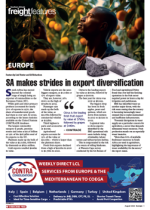Germany has been the leading destination for exports of South African-built vehicles since 2016, with the numbers holding steady, while other markets have been in decline.Europe accounted for R147.1 billion, or 54.3%, of the total automotive exports of R270.8bn in 2023 – or three out of every four vehicles exported.According to the International Organisation of Motor Vehicle Manufacturers, vehicle exports to Europe grew by 19%, from 15 079 901 in 2022 to 17 898 967 in 2023.The next-largest destination is the United States of America, followed by Japan, according to a study by TIPS (Trade & Industry Policy Strategies) senior economist Lesego Moshikaro-Amani and TIPS intern Nothembi Mahlangu.South Africa has advantageous access to Europe and the United Kingdom markets through free trade agreements.Within the European Union (EU), Germany was the biggest exporter of vehicles to SA, followed by Spain and then the United Kingdom in 2022.The German share is, however, declining, with India showing the biggest growth.German exports of components to SA have decreased from a 47% share of the total in 2015 to 34% in 2022, according to TIPS.SA exports of components for internal combustion engines are declining as Europe goes electric.The EU is the main destination for a number of South African automotive component categories, including catalytic converters, radiators/parts, and clutches/shaft couplings. Automotive component exports decreased by R3.34bn, or 10.5%, from the R31.9bn in 2022 to R28.6bn in 2023, mainly due to the decline in catalytic converter exports to the region.This is in line with an overall drop in SA exports of vehicle components.Global exports of components declined by R3.4bn year-on-year, from R70.3bn in 2022 to R66.9bn in 2023.Exports to the 13 new member countries, forming part of the expanded EU, comprised R7.5bn, or 5.1% of the R147.1bn export value in 2023, compared to the R8.8bn export value in 2022, according to the 2024 Automotive Trade Manual published by naamsa (the Automotive Business Council).There were increases in exports of alarms, body parts, axles, brake parts, clutches, engines, engine parts, gauges and instruments, radiators, seat belts, suspension parts and silencers.When combining exports of vehicles and components, Naamsa reports that the top destination in the UK and EU is Germany at R83bn, followed by Belgium at R34bn, Spain at R18bn and the UK at R14bn.

